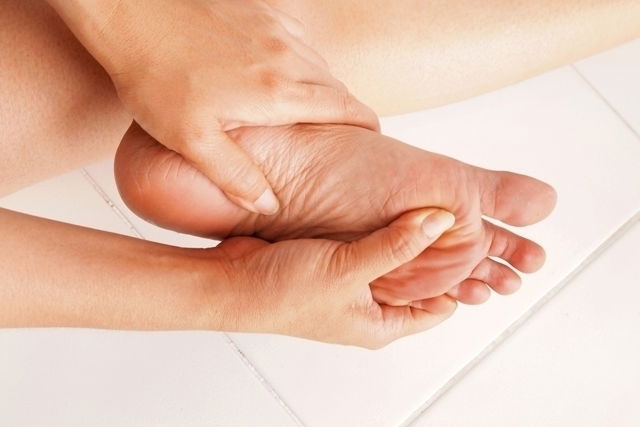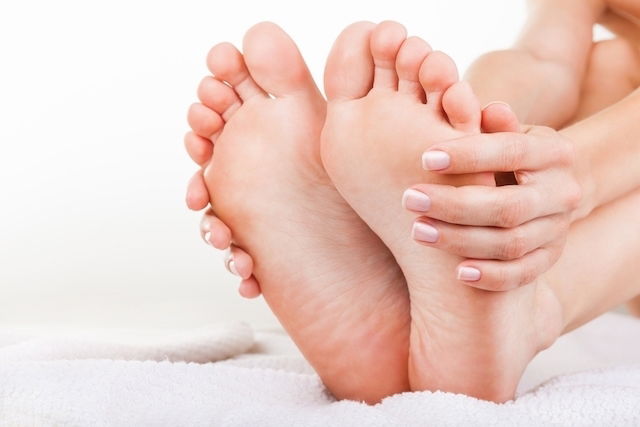Bottom of the foot pain can be caused by many foot conditions, like plantar fasciitis, ankle sprain or incorrect walking gait. These findings can be corrected within weeks to months with the right treatment.
Pain at the bottom of the foot may also be a result of abnormal anatomy, like having one leg shorter than the other or having a flat foot. Anatomical abnormalities can be corrected with physiotherapy and the use of orthotics.
To prevent bottom of foot pain, you should invest in adequate footwear that fit well and are appropriate for the activity at hand. You should care for your feet on a daily basis with stretching, massaging and adequate hygiene.

What causes bottom of the foot pain?
Pain at the bottom of the foot can occur for many reasons, like:
1. Bone spur
A bone spur is characterized by calcification of the ligament in the heel, which leads to the sensation of a small bone in the heel. It can cause pain and discomfort when walking or standing for prolonged periods on your feet.
What to do: To treat a bone spur, an orthopedic surgeon or physiotherapist can recommend silicone orthotics, stretching exercises and foot massages. In some cases, surgical removal of the spur may be necessary.
2. Plantar fasciitis
The fascia is a tissue that lines the tendons on the bottom of the feet. This tissue can become swollen, which is referred to plantar fasciitis. This condition can occur with long walks, tight footwear, frequently using high heels or obesity.
Plantar fasciitis can be noted with signs and symptoms like pain at the bottom of the foot, and the feeling of burning or discomfort. It is important to seek an assessment with an orthopedic surgeon or physiotherapist if symptoms do not resolve over time.
Learn more about the symptoms of plantar fasciitis and what can cause it.
What to do: Treatment for this type of inflammation is slow and is aimed at relieving symptoms and improving quality of life. To complement treatment, the doctor may prescribe anti-inflammatories, analgesics and physiotherapy to promote a speedy recovery.
3. Foot sprain
A foot sprain is a common injury among athletes, and is especially seen in runners. A sprain is characterized by an exaggerated twist of the angle, which can overstretch the ligaments and tear them. This can cause symptoms like pain at the bottom of the foot, swelling and difficulty walking.
What to do: To relieve pain and swelling, place a cold compress on the area for 20 minutes. If symptoms persist, you should proceed to the hospital for immobilization of the ankle.
4. Excessive exercise
Excessive exercise can also cause bottom of the foot pain. Depending on the exercise, heavy physical activity can cause swelling of the tissues and tendons in the area, leading to pain and discomfort.
What to do: In this case, it is best to rest with your feet elevated, and to soak your feet and lukewarm or cold water. You can also massage the foot to relieve pain.
5. Flat foot or everted foot
Flat feet or everted feet are anatomical abnormalities that can lead to foot pain. Flat foot may even leated to back pain, heel pain or knee problems.
What to do: For these cases, patients should see a physiotherapist or orthopedic surgeon for assessment. Based on the assessment, the doctor or therapist may recommend orthopedic shoes, orthotics, physiotherapy or even surgery.
6. Incorrect gait
Depending on how you walk or place your foot on the ground, some people may overload a specific part of the foot and experience pain in the heel, toes or bottom of the foot.
What to do: To relieve pain and correct gait, it may be interesting to engage in specific physiotherapy aimed at GPR, or global postural reeducation. This intervention can help to improve gait, correct posture and optimize knee positioning.
7. One leg shorter than the other
One leg is considered to be shorter than another if there is a measurable distance of more than 1 centimeter. The largest the distance, the more discomfort is felt. A shorter leg can occur when the leg bones are shorter, or if the hips are misaligned, causing symptoms like foot pain, back pain, knee changes and difficulty walking.
What to do: It is important for patients to see an orthopedic surgeon and a physiotherapist to prevent further complications. The doctor or therapist may recommend the use of special orthotics to balance out the length discrepancy, physiotherapy, and surgery in some cases.

Home remedies
A great home remedy for pain at the bottom of the foot is to remove your shoes and perform simple stretching exercises. Placing a hand on the bottom of the toes, pull the toes toward your stomach, and keep this position for about 1 minute before repeating. You can complete these stretch 3 times.
Massaging your feet is another simple and easy way to treat foot pain. Apply some moisturizing cream to foot, and with the palm of your hand, press into all areas of the foot, paying particular attention to areas where you feel pain.
How to prevent
To prevent bottom of the foot pain, you should ideally treat your pain every day. It is important to invest in high-quality footwear that is comfortable, light and well-fitting. Shoes should have a rubber sole and a small heel, or heels should be wide enough to ensure adequate balance when walking.
Patients who note foot pain when running should use running shoes that are designed for the pavement they are running on, whether it be on pavement, grass or sand. You should not run on grass or areas with lots of holes, as these can cause falls.
